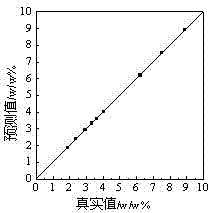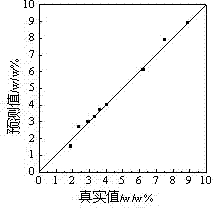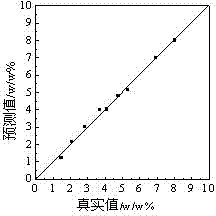Method for detecting coke deposition of catalyst by utilizing nuclear magnetic resonance
A technology of nuclear magnetic resonance and carbon deposition, which is applied in the direction of nuclear magnetic resonance analysis, etc., can solve the problems of slow detection speed, low detection accuracy, poor stability, etc.
- Summary
- Abstract
- Description
- Claims
- Application Information
AI Technical Summary
Problems solved by technology
Method used
Image
Examples
Embodiment 1
[0028] Using CP-MAS 13 The carbon spectra of 10 methanol-to-olefins SAPO-34 catalyst samples with known carbon content were detected by C NMR. The known sample is made by the catalyst evaluation device in the laboratory, and the amount of carbon deposit is analyzed by TG (thermogravimetric analyzer) in the laboratory. The amount of carbon deposition is controlled, so the distribution of the amount of carbon deposition of known samples obtained is not uniform.
[0029] Table 1 Known sample carbon deposition
[0030]
[0031] First, in order to eliminate the detection noise and effectively enhance the spectral information related to the component content, the raw spectral data was preprocessed with multivariate scatter correction.
[0032] Secondly, partial least squares regression and principal component regression were used to establish a correlation model between the carbon deposition amount and the peak area set of the sample, and the carbon deposition amount was predic...
Embodiment 2
[0036] Using CP-MAS 13 The carbon spectra of 10 methanol-to-propylene ZSM-5 catalyst samples with known carbon content were detected by C NMR. The known samples were prepared by the catalyst evaluation device in the laboratory, and the carbon deposition amount was analyzed by TG (thermogravimetric analyzer) in the laboratory. The known carbon deposition amount is shown in Table 3. Similarly, because the laboratory cannot perfectly control the carbon deposition amount according to the evaluation device, the distribution of the carbon deposition amount of the known samples obtained is not uniform.
[0037] Table 3 Known sample carbon deposition
[0038]
[0039] The same method as in Example 1 was used to establish a prediction model, and the results were predicted. The comparison between the predicted results and the actual results is shown in Figure 2, and the evaluation of the predicted results is shown in Table 4.
[0040] Table 4 Evaluation of prediction results
[00...
PUM
 Login to View More
Login to View More Abstract
Description
Claims
Application Information
 Login to View More
Login to View More - R&D
- Intellectual Property
- Life Sciences
- Materials
- Tech Scout
- Unparalleled Data Quality
- Higher Quality Content
- 60% Fewer Hallucinations
Browse by: Latest US Patents, China's latest patents, Technical Efficacy Thesaurus, Application Domain, Technology Topic, Popular Technical Reports.
© 2025 PatSnap. All rights reserved.Legal|Privacy policy|Modern Slavery Act Transparency Statement|Sitemap|About US| Contact US: help@patsnap.com



